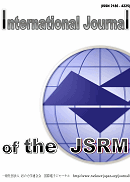This article is the summary for the thesis (Liu, 2016) receiving the best doctoral thesis award from the Japanese Society for Rock Mechanics (JSRM) in the fiscal year of 2016. First, a review study is presented to introduce previous studies on estimating permeability of discrete fracture networks. Mathematical expressions of permeability are summarized with the geometric properties, including: fracture length distribution, aperture distribution, fracture surface roughness, fracture dead-end, number of intersections, hydraulic gradient, boundary stress, anisotropy, and scale. Second, high-precision fluid flow tests and numerical simulations by solving the Navier-Stokes equations are conducted to investigate the nonlinear flow properties of fluid in both intersections and fracture networks. The results show that with the increment of the hydraulic gradient, the ratio of flow rate to hydraulic gradient decreases. When taking account of fracture surface roughness, the ratio of flow rate to hydraulic gradient would reduce by 0 - 26.55%. Finally, the fractal properties of rock fracture networks are characterized and a fractal model is proposed to link the fractal characteristics with the equivalent permeability of the fracture networks. The fractal dimension DT that represents the tortuosity of the fluid flow and another fractal dimension Df that represents the geometric distribution of fractures in the networks, are introduced into the model. The results indicate that compared with the parallel plate model, the maximum deviation of the calculated flow volume that considers the effect of tortuosity can be as high as 19.51%. A multiple fractal model for estimating the permeability of dual-porosity media is proposed. Analytical expressions for the fractal aperture distribution, the total flow rate, the total equivalent permeability, and the dimensionless permeability are derived. Thus the permeability of fractured rock masses could be easily assessed using the proposed method as a first order estimation.
View full abstract
